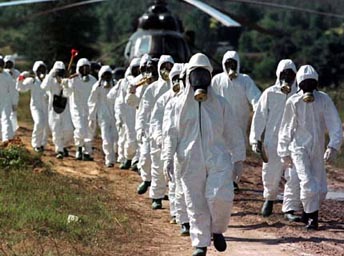 Credit: Agence France-Presse by SETH MYDANS, New York
Times
They emptied out chunks of the cement-like material from the white plastic sacks to use for tents and canopies and bedding. They ripped open the bags with their teeth to get string to use as clotheslines and as fasteners for oxcarts. They rinsed out the bags and used them to store rice. "We thought we were in luck!" said Em Sim, 35, laughing at her folly. "Yes, we thought this was our lucky day. For me the bags were just what needed to make a sleeping mat." The mat smelled a little like cement when she slept on it, she said. Then she started to have headaches. She began to feel thirsty and tired. She had difficulty breathing. She lost her appetite, suffered from diarrhea and began to lose weight. Her 5-year-old son, Chhien, who played in the dusty waste material while his mother gathered the sacks, has developed a rash and a fever and also has been losing weight, Mrs. Sim said. One after another, members of 40 families who evacuated the village of Bet Trang told similar stories of mysterious ailments that began after dozens of trucks arrived in the night and unloaded the material nearby. In the weeks since then, the dump has aroused international concern and caused a local panic. A dock worker who cleaned out the hold of a ship transporting the material died and five others were hospitalized. Learning of this, residents of Sihanoukville fled the city, then most of them returned. A riot broke out in the city center, damaging several buildings and leading to a dozen arrests, including two human rights workers who were advising the demonstrators on how to conduct a legal protest. A variety of tests determined that the waste material -- compressed ash from an industrial waste incinerator -- was contaminated with high levels of mercury as well as a possibly hazardous mix of other metals. But debate continued over the degree of danger it posed. The company that had sent the waste, Formosa Plastics Corp., said it had not been able to dump it in Taiwan because of a threat of public protests. The Cambodian government threatened to sue and Taiwan agreed to take the waste back. Workers have begun sealing it in barrels. The villagers said they first learned that they had been handling toxic material when local journalists arrived two weeks after it was dumped to take pictures of them. Just before Christmas, they said, the military sealed off the village and ordered them to leave. Apart from that, the villagers said, the government has ignored them. They have not been tested for poisoning, nor treated for their ailments. They have not been given alternative shelter. They are living as squatters and surviving on donations from the World Food Program. The people of Bet Trang spoke without anger. "You don't usually see people getting angry about things around here because they have taken so much in their lives from people who have more influence than they do," said Michele R. Brandt, an American lawyer who works with Legal Aid of Cambodia, a local human rights group. It remained unclear, one month after the dumping, just how toxic the material is and what had caused the villagers' symptoms. Ms. Brandt, whose organization is representing the affected villagers, said government officials, inexperienced in handling such emergencies, did not advise the villagers to move away when the possibility of poisoning was first raised. Georg Peterson, the Cambodian representative for the World Health Organization, told Reuters that although tests had shown "extremely high" concentrations of inorganic mercury, the material posed little immediate threat to health. He said that blood and urine tests on port workers and soldiers who have handled the material were normal and that "none seems to have symptoms of poisoning." But the evacuees interviewed here said they had not been tested, and Ms. Brandt said their exposure seemed to have been more direct and prolonged than that of the port workers and soldiers. Hun Vuthy, 15, was among a group of youngsters who had romped in the dumpsite. "We picked it up and played in it," he said. "It was interesting stuff and I was curious." He is now suffering from fever, diarrhea and weight loss. Lan Chan Heng, 30, ripped some of the bags apart with his teeth to get the string that was used to fasten them. He said he now suffers from a white discharge from his eyes and from pain in his eyes and bones and joints that keeps him awake at night. Khuan Kong, 36, who has four small children, gave birth to a fifth child 15 days ago, before the villagers were evacuated. She also had collected bags from the dump and is worried about the effects on her children. The worst problem, Mrs. Sim said, is that the people of Bet Trang now have no homes and no work. She said she was eager to return home. "We are waiting for the government to tell us we can go back," she said. "As soon as they tell us it's safe, we'll go." FAIR USE NOTICE. This document contains copyrighted material whose use has not been specifically authorized by the copyright owner. The Basel Action Network is making this article available in our efforts to advance understanding of ecological sustainability and environmental justice issues. We believe that this constitutes a `fair use' of the copyrighted material as provided for in section 107 of the US Copyright Law. If you wish to use this copyrighted material for purposes of your own that go beyond `fair use', you must obtain permission from the copyright owner. More News |
|
|